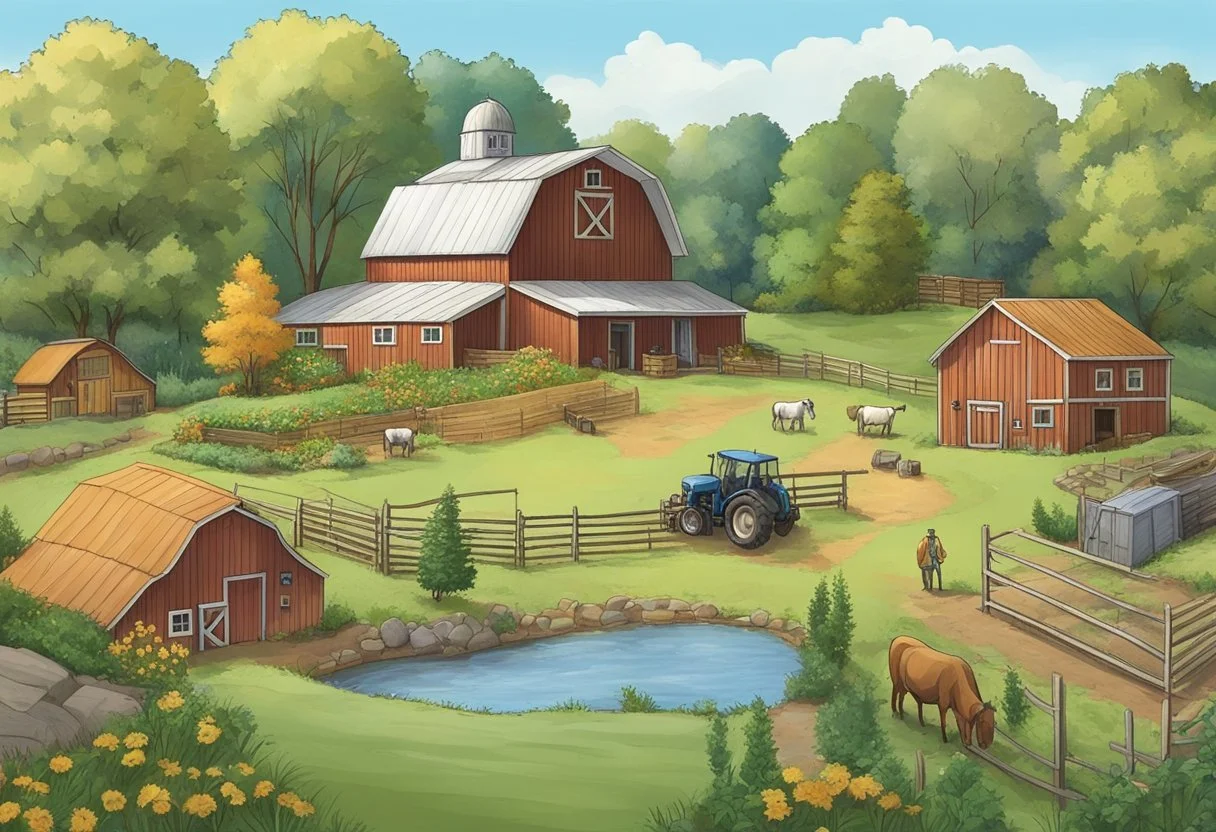Homesteading in Minnesota
Effective Strategies and Tips
This Article is Part of Our Guide Homesteading State by State
Homesteading in Minnesota has gained increased popularity in recent years, as more people seek to reconnect with nature and live a more sustainable lifestyle. The practice of establishing a self-sufficient home on a small acreage provides numerous opportunities for those willing to face the challenges and embrace the rewards of a simple, yet fulfilling way of life. Minnesota, generously endowed with fertile soil and ample water sources makes an ideal destination for aspiring homesteaders.
While embarking on the journey to create a small-hold farm in the Midwest may seem overwhelming, following a well-researched plan and utilizing available resources can streamline the process. Diverse climate and landscape characteristics of Minnesota create ideal conditions for both large-scale agriculture and small-acreage homesteading. From gardening and raising animals to incorporating renewable energy technologies, prospective homesteaders can tailor their endeavors to best suit their needs and values.
Understanding the legal framework, tax incentives, and local zoning regulations is crucial for the success of any small-acreage homestead in Minnesota. As homesteaders work to cultivate and maintain their land, they simultaneously contribute to a sustainable future for the state. The resulting sense of self-reliance and deeper connection with the environment fosters a greater appreciation for the land's abundance and the homesteading lifestyle.
What is the Homesteading Exemption in Minnesota and is it Related to Farming?
In Minnesota, the homestead classification is a property tax relief program for homeowners, but it is not directly related to farming.
The key details:
The homestead classification designates an owner-occupied primary residence as "homestead property" for tax purposes.
This lowers the taxable value used to calculate property taxes.
To qualify, the owner must occupy the property as their principal place of residence.
It provides tax relief specifically for eligible owner-occupied homes.
Agricultural land may qualify for the "Green Acres" program if used for farming. This offers a lower tax rate.
Green Acres has separate eligibility focused on commercial agricultural use.
Homestead classification applies only to primary residences, separate from agricultural tax programs.
In summary, Minnesota's homestead classification is intended to provide residential tax relief. Agricultural land could receive preferential tax treatment under Green Acres to support farming. But homestead is not related to agriculture.
Understanding Homesteading
Homesteading Basics
Homesteading is a lifestyle characterized by self-sufficiency, where homesteaders strive to produce their own food, clothing, and other necessities, often within a small-acreage setting. This type of lifestyle is appealing to many because it allows for a closer connection to the land, reduced dependence on external resources, and increased self-reliance.
Embarking on a homesteading adventure in Minnesota means taking control of one's own journey towards a more sustainable and simple way of living. Some key aspects of homesteading include:
Agriculture: Growing fruits, vegetables, and other crops on a small scale for personal consumption or sale
Animal husbandry: Raising livestock, such as poultry, cattle, or goats, for meat, milk, and eggs
Preservation: Canning, freezing, or drying food to extend their shelf-life
Handmade goods: Producing items like clothing, furniture, and tools through various crafts and techniques
Aside from these practices, homesteading often involves adopting a more sustainable lifestyle, which includes utilizing renewable energy sources and conserving resources where possible.
Significance of Homesteading
Homesteading may be viewed as a reaction to modern society's dependence on consumer culture and environmental degradation. By adopting a more minimalistic and sustainable way of living, homesteaders aim to reduce their ecological footprint and mitigate the negative impacts of consumerist lifestyles.
In Minnesota, small-acreage homesteading is well-suited to the region's fertile soil and diverse ecosystems, making it an ideal location for those interested in pursuing this way of life. In addition, the state offers various programs and resources, such as the Sustainable Farming Association, which aims to support and promote sustainable agriculture practices, ensuring a successful homesteading journey for those who choose it.
Taking up the homesteading lifestyle is not only a reflection of individual values but also contributes to the preservation and regeneration of our natural environment. By engaging in self-sustaining practices and reducing dependence on non-renewable resources, homesteaders actively contribute to a more sustainable and Earth-conscious society.
Choosing the Right Acreage in Minnesota
When looking for a suitable acreage for homesteading in Minnesota, several factors should be considered. These factors include location, land prices, permits, and regulations. This section provides a brief overview of these crucial considerations.
Firstly, think about the location of the land. Minnesota offers various climatic conditions and landscapes, making it essential to select an area that aligns with one's farming priorities. For instance, northern Minnesota is known for its cool temperatures and fertile soil, suitable for crops like potatoes and grains. On the other hand, southern Minnesota has a milder climate, making it ideal for growing soybeans and corn.
In terms of land prices, Minnesota's real estate market offers a wide range of options. Here is a rough price guide for buying farmland:
It's also important to note that purchasing land may require a substantial down payment. Therefore, working with a knowledgeable real estate agent is advised as they can help navigate the buying process and find affordable options.
Before purchasing land, ensure that it complies with local zoning laws and permits. Minnesota's zoning laws regulate land use and may differ from one county to another. Some areas may have restrictions on farming activities, the construction of outbuildings, or raising livestock. Familiarize with homestead laws in the chosen area to understand the statute and exemptions that may apply.
Homestead exemptions can offer protection to homeowners from creditors, up to a specific property value. For instance, Minnesota has a homestead exemption that secures up to $390,000 in property value, increasing to $975,000 for agricultural homesteads. It is crucial to know and understand these exemptions when purchasing land for a homestead.
Lastly, it's important to mention the federal Homestead Act of 1862, which authorized free land for people to settle across the United States. This act is no longer in effect, but some areas still offer affordable land for homesteading.
In conclusion, when searching for a small acreage in Minnesota, carefully consider the location, land prices, permits, and regulations. By seeking assistance from a real estate agent and familiarizing oneself with local laws, one can confidently make informed decisions in choosing the perfect acreage for homesteading.
Farm Set Up and Management
Farming Basics
When setting up a small acreage farm in Minnesota, the first step is to carefully plan the layout of the garden and farming areas. Consider the natural factors such as sunlight exposure, irrigation sources, and soil quality. Incorporate crop rotation and intercropping strategies to maintain soil fertility and reduce pest issues.
Minnesota is known as the "Land of 10,000 Lakes," which helps create a diverse ecosystem, perfect for a wide variety of plants and crops. The farming lifestyle in the Midwest is peaceful and deeply connected to the agricultural roots of the region.
Seasons are essential in planning your farm activities. Here's an outline to help you understand the farming seasons in Minnesota:
Spring: Preparing the soil, planting, and early growth
Summer: Managing water, pests, and weeds; monitoring crop growth
Fall: Harvesting, preserving, and storing produce
Winter: Rest, planning, and maintenance
Crop Management
Managing your crops efficiently in Minnesota's climate is essential for success. Choose a mix of crops that grow well in the region to ensure a bountiful harvest. Prioritize the following factors when selecting crops:
Compatibility with the local climate
Resistance to pests and diseases
Adaptability to soil conditions
Market demand and profitability
Keep track of your crop plan in a dedicated notebook or digitally to monitor each crop's progress.
Below is a table of common crops grown in Minnesota and their planting and harvesting seasons:
Soil Management
Maintaining soil quality is crucial for the long-term success of a small acreage farm in Minnesota. When setting up your farm, conduct a soil test to analyze the nutrient and pH levels. Amend the soil as needed based on the test results, using organic matter and fertilizers.
Effective soil management techniques include:
Rotating crops: Changing the crops grown in a specific area each year to help preserve soil fertility
Cover cropping: Using plants like legumes during the offseason to add nutrients to the soil and prevent erosion
Composting: Producing organic fertilizer from kitchen scraps, leaves, and other organic materials
Combining these techniques will help you achieve the ultimate goal of fertile soil to support the growth of healthy plants and crops on your Minnesota farm.
Housing and Infrastructure
Building Your Homesteading House
When it comes to building a house on your small acreage homestead in Minnesota, it is crucial to focus on quality construction. Investing in durable materials and well-executed design will allow your family to enjoy a comfortable and secure living space for years to come. When planning the layout, consider integrating common areas for food preparation, social interaction, and workspaces to foster community.
In addition to quality, eco-friendliness should be taken into account during construction. For a more sustainable homestead, consider incorporating energy-efficient windows, solar panels, or green building materials.
Managing Heating and Insulation
Heating is a critical aspect to consider when setting up your homestead in Minnesota, particularly due to the severe winters. Incorporating a wood stove can provide a reliable and renewable source of heat. The energy generated by a wood stove is measured in British Thermal Units (BTUs). Ensure your stove's BTU output is sufficient to heat the intended space.
Proper insulation is essential in minimizing heat loss and maintaining a comfortable indoor temperature. Investing in high-quality insulation materials and installation will save on energy costs and reduce the need for constant heating. Some insulation options include fiberglass, cellulose, and spray foam. Be sure to research the best insulation method for your specific needs and location.
Understanding Zoning Regulations
Before moving forward with your Minnesota homestead plans, it's essential to research and understand the zoning regulations that apply to your property. These regulations dictate the use of land and can impact the types of structures you're allowed to build (including taverns, sheds, and other outbuildings), as well as specific requirements for your house.
To access the relevant information, consult your local government office or their website for zoning maps, documents, and specific regulations. In many cases, specific zoning regulations can also be found in PDF format, making it convenient to download and review them at your leisure.
Overall, developing a successful small acreage homestead in Minnesota requires careful planning and research, particularly when it comes to housing and infrastructure. By prioritizing quality construction and materials, managing heating and insulation effectively, and understanding the relevant zoning regulations, you'll be well on your way to creating a comfortable, sustainable, and efficient homestead for your family.
Battling Minnesota's Weather
Minnesota is known for its extreme climate, with harsh winters, short growing seasons, and unpredictable weather patterns. Homesteaders seeking to establish a flourishing lifestyle on small acreage in this region must prepare for and adapt to these challenging conditions. In this section, we will discuss ways to cope with the state's distinctive weather.
Winter is perhaps the most formidable season for Minnesotan homesteaders. The state experiences frigid temperatures, often dipping below 0°F, along with substantial snowfall. To ensure the well-being of both people and animals on the homestead, it is essential to have well-insulated and heated shelters. Stock up on firewood, back-up heating sources, and extra blankets to remain warm during these cold winters. In addition to keeping warm, proper snow removal equipment, such as snow blowers or plows, is crucial for maintaining access to and from the property.
Despite the long, cold winters, Minnesota does have a growing season. This period typically spans from late April to mid-October, depending on the area of the state. To make the most of this narrow window, gardeners should plan their planting schedules accordingly. Choosing cold-hardy crops, such as kale or beets, and utilizing season extenders like cold frames or hoop houses can maximize the growing season. Additionally, staggered planting techniques and appropriately timed transplanting can help ensure successful harvests, despite the region's challenging climate.
The unpredictable nature of Minnesota's seasons may present additional difficulties for homesteaders. Spring often brings heavy rain, while summer can involve heatwaves and drought conditions. Being prepared for sudden changes in weather is essential for the health and productivity of your homestead. This preparation may include having an adequate water storage system with an irrigation setup for periods of drought or implementing drainage systems to counter flooding from heavy rain or melting snow.
In conclusion, homesteading in Minnesota on a small acreage demands resilience and adaptability. By preparing for the state's extreme climate, short growing season, and unpredictable weather patterns, homesteaders can create a sustainable home and productive garden in this challenging environment.
Livestock and Poultry
When starting a homestead in Minnesota, raising livestock and poultry can be an excellent way to become more self-sufficient. Some popular animals to consider include chickens, goats, and even deer for various purposes. This section discusses each of these animals and their benefits on a small acreage.
Chickens are often the first choice for many homesteaders. They are relatively easy to care for, requiring only a secure coop, a small amount of outdoor space, and a balanced diet. In return, they provide a steady supply of fresh eggs and can help control pests in the garden. Some common breeds that fare well in Minnesota’s climate include Rhode Island Reds, Plymouth Rocks, and Orpingtons.
Goats are another excellent addition to a small homestead in Minnesota. They are versatile animals that can be raised for milk, cheese, and even meat. Goats are also efficient at clearing brush and weeds from overgrown areas. Some popular breeds for small acreage homesteads are Nigerian Dwarfs and Pygmy goats, as they are small in size and require less space compared to their larger counterparts.
While raising deer may not be as common as other livestock, they can be a valuable source of meat for a Minnesota homestead. Minnesota has a rich deer population, making them a sustainable option for those with adequate fencing and land. Whitetail deer typically require a minimum of two acres per animal for grazing and browsing.
In addition to these larger animals, small acreage homesteads can also look into fishing to supplement their protein sources. Minnesota is known as the "Land of 10,000 Lakes," making fishing a viable option for many homesteaders. Species like Walleye, Northern Pike, and Largemouth Bass can be found in the various water bodies throughout the state.
Here is a brief summary of the animals discussed:
In conclusion, the choice of livestock and poultry on a Minnesota homestead will largely depend on the available space, resources, and personal preferences. By carefully selecting animals that suit their needs, homesteaders can create a sustainable and productive small acreage in Minnesota.
Food Self-Sufficiency
Homesteading in Minnesota offers a variety of opportunities to achieve food self-sufficiency. Embracing gardening, raising animals, and utilizing local resources like wild rice (how long does wild rice last?) and wildlife allows homesteaders to minimize their dependency on external food sources.
Gardening is an essential aspect of a self-sufficient lifestyle. In Minnesota, homesteaders can create a productive garden by taking advantage of the state's fertile soil and ample rainfall. However, it is crucial to consider the heavy snow that may affect the gardening season. One can extend the gardening period by using cold frames or hoop houses. A well-tended garden can provide a variety of vegetables, fruits, and herbs throughout the year.
When planning a garden, it is essential to know when to till the soil and plant the seeds. A beneficial resource for this is the USDA plant hardiness zone map, which indicates the best planting times for the region.
A crucial aspect of achieving food self-sufficiency is raising animals for meat, dairy, and eggs. Chickens are an excellent choice, as they can be raised for both eggs and meat, and can thrive on a small acreage. Other animals to consider include goats, pigs, and rabbits.
In Minnesota, cottage food laws allow homesteaders to sell their homegrown and homemade products under certain conditions. Consult local resources to determine the necessary permits and certifications required to sell homemade food at farmers' markets or to neighbors.
Wild rice, a staple grain in Minnesota, is highly nutritious and can be harvested from the region's lakes and rivers. Incorporating wild rice into the homestead's diet can promote self-reliance and support local ecosystems.
Venison is another significant resource for Minnesota homesteaders, as deer are plentiful in the region. Hunting can provide an essential source of protein while helping control the deer population.
Preserving food is necessary for achieving self-sufficiency throughout the year. A root cellar is an age-old method of preserving vegetables and fruits during winter months. Fermenting, canning, freezing, and dehydrating are other recommended food preservation techniques.
Finally, taking advantage of local wildlife by fishing, hunting, and foraging can significantly contribute to a homesteader's food self-sufficiency in Minnesota.
In conclusion, by incorporating a combination of gardening, raising animals, preserving food, and utilizing local resources, Minnesota homesteaders can achieve a greater level of food self-sufficiency on their small acreage.
Local Resources and Community
Minnesota, known for its beautiful landscapes and rich natural resources, offers a welcoming environment for homesteaders establishing themselves on small acreage. One key factor to consider when looking at locations in Minnesota is the availability of local resources and support from the community.
When choosing a location, it is essential to research local regulations in the area. Different counties in Minnesota have specific zoning and land-use regulations that may affect your homestead plans. Additionally, some areas have associations or community organizations that set other restrictions on property use. Take these factors into account before choosing a location for your homestead.
Natural resources are abundant in Minnesota, which offers opportunities for logging, especially in the northern part of the state. This can provide a source of income for some homesteaders, but make sure you adhere to the strict environmental and logging regulations in place. Sustainable forestry practices are often encouraged to maintain the health and beauty of Minnesota's forests.
When searching for a suitable property, a knowledgeable real estate agent can be an invaluable resource. Look for an agent experienced in rural properties and familiar with the unique concerns and requirements of a homestead. They can help you navigate the process and negotiate the best possible deal.
For supplies, tools, and equipment essential for your homestead, online resources such as Amazon.com can be helpful, especially if you are in a remote location. However, don't forget to explore local businesses that may offer the benefit of personalized advice and support.
A strong sense of community is vital for a thriving homestead. In Minnesota, various community organizations, such as the Sustainable Farming Association and the Minnesota Department of Agriculture, offer resources and assistance to homesteaders. Connecting with local farmers, markets, and Co-ops can lead to valuable networking, learning, and collaboration opportunities.
Involving your family in the homesteading process is key to a successful transition. Minnesota offers excellent schools, healthcare facilities, and recreational activities, ensuring a high quality of life for you and your loved ones.
The appeal of homesteading in Minnesota on small acreage lies in the balance between self-sufficiency and the support of local resources and community. By taking advantage of these resources, aspiring homesteaders can confidently establish themselves in this beautiful state.
Conclusion
Embarking on the journey of homesteading in Minnesota provides an opportunity for individuals and families to create a self-sufficient, sustainable lifestyle. With careful planning and dedication, it is possible to make the most out of a small acreage in this beautiful state.
Considering the available space is crucial when planning a homestead on a small acreage in Minnesota. Making efficient use of the land and resources can maximize productivity. For example, implementing permaculture practices or utilizing vertical planting methods can optimize crop yields.
Developing a variety of skills is essential for a successful homesteading experience. From gardening to animal husbandry, carpentry, and food preservation, acquiring knowledge in these areas will prove invaluable. Additionally, taking advantage of local workshops, online resources, and connecting with fellow homesteaders through community groups can aid in skill development.
However, homesteading can be both rewarding and challenging. Finding a balance between work, family life, and homestead responsibilities may require patience and perseverance. Moreover, Minnesota's climate can bring harsh winters, posing unique challenges that homesteaders need to prepare for, such as proper livestock shelter, heating solutions, and winter food storage.
Budgeting is another crucial aspect of managing a small homestead. Tracking expenses, creating a financial plan, and finding ways to cut costs (like reusing materials, growing food, and creating homemade products) can help keep the homestead running smoothly.
In conclusion, homesteading in Minnesota on a small acreage combines the joys of self-sufficiency with challenges unique to the region's climate and land availability. By strategically planning, honing essential skills, and keeping a careful eye on resources and budget, many find the rewards of this lifestyle outweigh the challenges, making it a fulfilling and sustainable experience.






